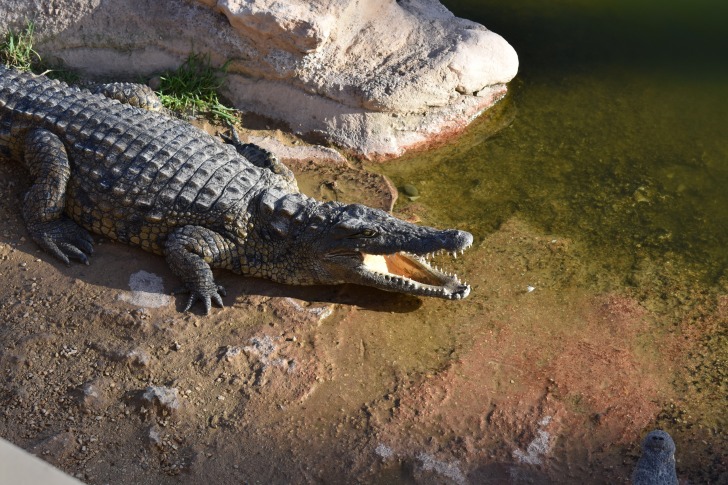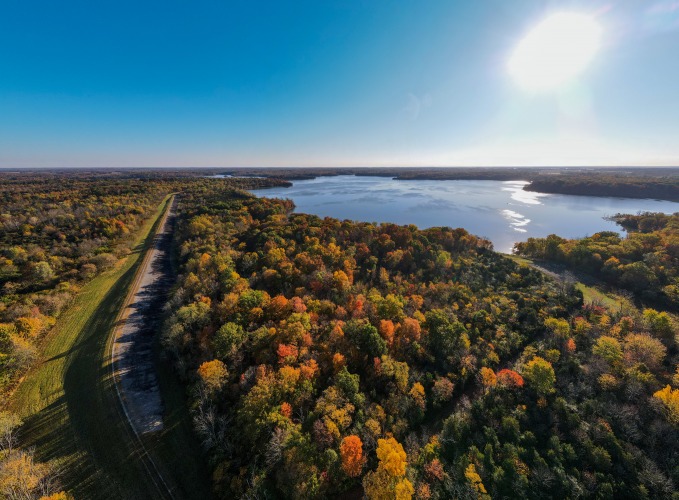Alligators live near the coast of the Southeastern United States because it is warm and there are a lot of wet marshy-type areas.
Ohio has the Great Lakes, and big rivers, but not a lot of swamps.
It is not the kind of place you would expect to find a cold-blooded creature whose body cannot adjust to the cold very well.
Ohio has cold weather and snow, and alligators will have a tough time in that environment.

Contents
So… Are There Alligators in Ohio?
Based on the environment and geography, there should not be any alligators in Ohio.
If there are, they did not get there naturally.
Even so, there are a few found from time to time.
Three alligators have been found over the past three years in Akron, at Summit Lake, which is within the city limits.
They were found between 2006 and 2010, and there have not been any found since then.
Two were caught by people fishing, and they were all about four feet long each.
Some people have said they saw some that were five feet long.
There is a factory that pumps hot water into the lake, which keeps the water warm throughout the year, so it is possible an alligator could survive the winter in that lake.
Any alligators living in Ohio are either living in a zoo or are a creature someone has bought as a pet.
When they get to a certain size, people cannot take care of them and release them into a lake or stream.
Police in the town of Groveport reported finding a 25-year-old adult alligator in a private home.
The animal was removed and shipped to South Carolina.
You must have an exotic pet license to own an alligator in Ohio, and there are some people who do.
About 20 people are licensed to own alligators in Cleveland alone.
There have been stories of alligator sightings in the Ohio River, but fish and wildlife officials say they have not found any.
They look for them when they are reported but say they never found one.
Alligator Species in Ohio
There are no natural alligators in Ohio, but there have been some released into the wild.
All alligators living in the United States are American Alligators.
There are only two species of alligator, the other one is in China.
Alligators are a species of crocodile, and there are several species of crocodile.
There was an actual crocodile found in Ohio a few years ago.
The American alligator likes warm weather and likes to live in wet marshy or swampy areas.
The ones reported in Ohio were of that species.
They have been making their way north gradually as the climate changes, but they have not gotten to Ohio on their own yet.
Is it Safe to Swim in Ohio?
It is safe to swim in a lot of places in Ohio.
There are great lakes that have beaches, and many areas are fine for swimming.
Rivers and lakes are also a possibility, but some have pollution issues.
The dangers of swimming in Ohio are more related to common water hazards that have little to do with wildlife.
Boating accidents are a common cause of drowning, rather than swimming.
It would be extremely unlikely to come across an alligator while swimming in Ohio.
The few that have been found are at the small lake in Akron that is closed to swimming because of pollution issues.
It is, however, open or fishing.
The Ohio River is a popular place to swim and has the usual hazards that any river would have.
Currents under the surface can be tricky, and there is floating or submerged debris you cannot see.
About 40 years ago, the Ohio River was polluted to the point that it was not safe for swimming.
Now the water is fine for swimming 90 percent of the time, state health officials said.
Swimming in polluted water is a concern in Ohio.
Make sure the area is safe from pollution before swimming.
Interesting Alligator Facts in Ohio
There were three alligators taken from the same area of Summit Lake in Akron, which is a fairly large city.
Wildlife officials believe these were put in the water by people who had them as pets and could no longer handle them.
Alligators have a brumation phase when it gets below 55 degrees, which is similar to hibernation in mammals.
Their body slows down a lot, their heart rate and breathing slow, and they do not eat for a very long time.
It is doubtful if one could survive if the water was close to the freezing point, but with brumation, they could stay alive in fairly cold water for a long time.
It is fairly often claimed that alligators have been spotted in the Ohio River.
State officials believe this is a myth because it has been investigated and none were found.
Still, the reporting persists, so maybe someday one will be found.
In 2019 a church group of kids found a 10-foot-long alligator while on an outing in rural Preble County north of Cincinnati.
They were swimming in the creek when they saw the alligator.
They quickly got out of the water and watched the gator swim as they watched from a bridge.
The alligator was shot by wildlife officials the next day.
Alligators do not eat as much as you might think.
They usually eat about once a week.
Fat is stored in their tail, and they can live more than a year without eating at all.
They can get very big, but do not need a lot of food.
An 800-pound alligator would eat less than a 100-pound dog would over the course of a year.
Alligators live in the southeastern United States and in China.
Crocodiles live in coastal areas where it is hot around the world.
There is the American Crocodile on the southern tip of Florida.
It is the only place in the world where alligators and crocodiles live together.
Alligators vs. Crocodiles
The words Alligator and Crocodile are used interchangeably in the modern American language.
They are closely related biologically, but they are different species.
Both are in the Crocodilian family and have some distinct differences:
- Size. Alligators are between eight and 11 feet long and weigh between 400 and 800 pounds. Crocodiles are much larger, with some getting as big as 20 feet long, and they can weigh up to 2,000 pounds.
- Coloring. Alligators are black or dark gray and have a cream-colored underside. Crocodiles are green or light brown, and are lighter underneath but not a different color.
- Mouths. Alligators have a U-shaped snout, rounded at the end. Crocodiles have a more V-shaped snout that is more narrow. This allows alligators to hide their teeth when they close their mouths. Because of the snout shape, Crocodile teeth are visible when the mouth is closed.
- Teeth. Alligators have about 80 teeth and crocodiles have a set of 66.
- Feet. Alligators have webbed feet that give them more swimming ability, and they move through the water fast. Crocodiles do not have webbed feet, but they have a jagged edge on their feet, which allows them to hold on to things better. They are not as good swimmers as alligators.

3 Safety Tips for Swiming in Alligator-infested Waters
You should not have to worry about coming across an alligator while swimming in Ohio, but anything could happen.
Still, there are some swimming safety tips that will suit any situation.
There were 20 drowning deaths in Ohio in 2020, which is among the lowest in the state in the nation.
- Swim in designated areas. One of the great dangers is things you cannot see under the water, such as debris, structures, or dangerous creatures. Areas that are determined safe are designated for swimming. This is particularly true in rivers that often do not have clear water.
- Be aware of your surroundings. If you see an alligator in the water or something dangerous like a snake, get away from it as fast as you can. Stay at least 50 feet away. Alligators are very fast for short distances, but they cannot chase for long. Fish are not often a hazard, but there are some fish that could be, such as catfish, which have strong mouths and they have spines sticking out that can hurt you.
- Don’t swim alone or after dark. Alligators, and most other animals too, like to look for food at night. Swimming at night puts you in more danger of running across an animal looking for food. Swimming alone is also dangerous because there is no one to help you if you do happen to get in trouble.
Summary
There are no native alligators in Ohio, but there are a few that have been released by people.
They get too big and people can’t care for them, so they release them in a pond or river.
These alligators could be dangerous, and they will likely freeze to death in winter.
Some have been found in a specific area, which is suspicious, but they are found at times at different places in the state.
Ohio Safety Overview
READ THE FULL REPORT: Ohio Safety Review
Safety Index:
- OVERALL RISK: LOW
- TRANSPORT & TAXIS RISK: LOW
- PICKPOCKETS RISK: LOW
- NATURAL DISASTERS RISK: MEDIUM
- MUGGING RISK: LOW
- TERRORISM RISK: LOW
- SCAMS RISK: LOW
- WOMEN TRAVELERS RISK: LOW
Frequently Asked Questions
What and how much do alligators eat?
Adult alligators like to eat fish, snakes, turtles, birds, and small mammals, and they have been known to eat a dog now and then.
Young alligators also eat insects and small crustaceans in addition to fish.
It is very rare for an alligator to eat a human, but they have attacked people and killed them in the past.
There have been no reports of injuries due to alligators in Ohio.
Because of how their bodies are made, alligators do not need to eat a lot.
They eat only about once a week and can go as long as a year without eating if they have to.
How are alligators doing as a species?
They are doing well now, but they almost went extinct.
They were listed as an endangered species in the early 1970s when they had been hunted to the point that there were not many of them anymore.
Today, their numbers have climbed and they stretch from the gulf coast of Mexico, around Florida, and north to Virginia.
They are slowly making their way more inland but still tend to stick to coastal areas even though they are not saltwater animals.
Hunting them was illegal for a long time, but now there are controlled hunts in southern states as the population continues to grow.
Where can you see alligators in Ohio?
The simple answer is at a zoo.
The Columbus Zoo and Aquarium has a reptile room that has several American Alligators, as well as some crocodiles.
Last year, a two-foot young alligator was found by sewer workers in Cleveland and rescued.
That alligator is now living at the Metroparks Zoo in Cleveland.
Most large zoos in the state will have a reptile section with alligators.












Swimming in Ohio is safe, but there are some things to watch out for.
There have been a few alligators found in the state over the years, and they were probably pets that got too big.
Ohio may not seem like an ideal place for alligators due to its cold weather and lack of swamps, but there have been sightings of these creatures as people release them into lakes or rivers when they can no longer care for them. Swimming in designated areas and being aware of your surroundings can help ensure safety while swimming in Ohio’s waters.